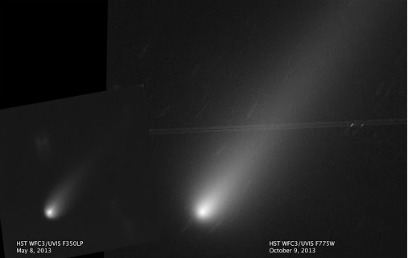Comet ISON Will Likely Stick Together for Trip Around Sun
New Hubble pictures show that rumors of a breakup are premature

Hubble images of Comet ISON in May and October, showing the difference in brightness and relative size in the sky. Credit: NASA, ESA, and the Hubble Heritage Team (STScI/AURA)
Comet ISON has been the subject of all sorts of predictions since it was discovered just over a year ago. First it was thought that ISON will be the most spectacular comet seen in a generation when it draws close to the sun late this November. Then some astronomers in Colombia insisted the comet was fizzling — that is, breaking into pieces — as comets sometimes do. But most other astronomers decided to wait and see.
Released today, new images from the Hubble Space Telescope reveal that Comet ISON is sticking together so far. “It’s overhyped, it’s underhyped. Just let it be what it is,” said astrophysicist Bonnie Meinke this afternoon during a Google Hangout with other scientists tracking the comet.
On November 28, ISON will make its closest pass to the sun, approaching just about one million miles above the surface. The “sungrazer” will be so close that the sun’s magnetic field will yank on charged dust and gas particles in the comet’s tail, likely creating “waves and puffy bits,” said Meinke, much like Comet Lovejoy in 2011. The solar observatories — SDO, SOHO, and STEREO — as well as the Mercury orbiter MESSENGER, will all turn their eyes to the comet as it passes.